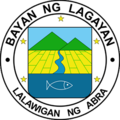Lagayan | |
|---|---|
| Municipality of Lagayan | |
 Map of Abra with Lagayan highlighted | |
Location within the Philippines | |
| Coordinates: 17°43′N120°43′E / 17.72°N 120.71°E | |
| Country | Philippines |
| Region | Cordillera Administrative Region |
| Province | Abra |
| District | Lone district |
| Barangays | 5 (see Barangays) |
| Government | |
| • Type | Sangguniang Bayan |
| • Mayor | Edmarc L. Crisologo |
| • Vice Mayor | Apolinar B. Molina |
| • Representative | Menchie B. Bernos |
| • Municipal Council | Members |
| • Electorate | 3,510 voters (2025) |
| Area | |
• Total | 215.97 km2 (83.39 sq mi) |
| Elevation | 203 m (666 ft) |
| Highest elevation | 742 m (2,434 ft) |
| Lowest elevation | 67 m (220 ft) |
| Population (2024 census) [3] | |
• Total | 5,154 |
| • Density | 23.86/km2 (61.81/sq mi) |
| • Households | 1,085 |
| Economy | |
| • Income class | 5th municipal income class |
| • Poverty incidence | 25.65 |
| • Revenue | ₱ 39.58 million (2012), 43.72 million (2013), 41.23 million (2014), 56.73 million (2015), 65.44 million (2016), 64.77 million (2017), 95.31 million (2018), 91.45 million (2019), 134.4 million (2021) |
| • Assets | ₱ 40.08 million (2012), 36.78 million (2013), 37.22 million (2014), 37.72 million (2015), 48.92 million (2016), 86.87 million (2017), 165.9 million (2018), 219.1 million (2019), 327.1 million (2021) |
| • Expenditure | ₱ 22.41 million (2012), 35.11 million (2013), 32.5 million (2014), 40.9 million (2015), 56.44 million (2016), 50.61 million (2017), 53.6 million (2018), 67.32 million (2019), 84.1 million (2021) |
| • Liabilities | ₱ 26.8 million (2012), 23.84 million (2013), 20.88 million (2014), 17.88 million (2015), 15.89 million (2016), 39.68 million (2017), 77.03 million (2018), 60.39 million (2019), 44.25 million (2021) |
| Service provider | |
| • Electricity | Abra Electric Cooperative (ABRECO) |
| Time zone | UTC+8 (PST) |
| ZIP code | 2824 |
| PSGC | |
| IDD : area code | +63 (0)74 |
| Native languages | Itneg, Ilocano, Filipino |
Lagayan, officially the Municipality of Lagayan (Ilocano : Ili ti Lagayan; Adasen : Ili u Lagayan; Filipino : Bayan ng Lagayan), is a municipality in the province of Abra, Philippines. According to the 2024 census, it has a population of 5,154 people. [5]



